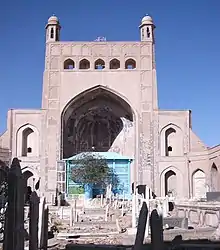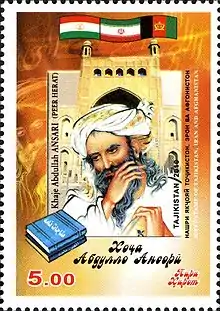Khwaja Abdullah Ansari
Abu Ismaïl Abdullah al-Herawi al-Ansari or Abdullah Ansari of Herat (1006–1088) (Persian: خواجه عبدالله انصاری) also known as Pir-i Herat (پیر هرات) "Sage of Herat", was a Muslim Sufi saint [7][8] who lived in the 11th century in Herat (modern-day Afghanistan). One of the outstanding figures of 5th/11th century Khorasan, Ansari was a commentator of the Qur'an, traditionist, polemicist, and spiritual master, known for his oratory and poetic talents in Arabic and Persian.[9]

Abdullah Ansari | |
|---|---|
 Abdullah Ansari portrayed on a stamp in Tajikistan (2010) | |
| Shaykh al-Islām, Sage of Herat | |
| Born | 1006 Herat, Khorasan, Ghaznavid Empire |
| Died | 1088 (aged 81-82) Herat, Khorasan, Ghaznavid Empire |
| Venerated in | Sufism |
| Major shrine | Tomb of al-Ansari, Herat |
Khwaja Abdullah Ansari | |
|---|---|
| Personal | |
| Religion | Islam |
| Denomination | Sunni Islam |
| Jurisprudence | Hanbali[1] |
| Creed | Athari[2] |
| Movement | Sufi[3] |
| Muslim leader | |
Influenced
| |
Life
He was born in the Kohandez,[9] the old citadel of Herat, on 4 May 1006. His father, Abu Mansur, was a shopkeeper who had spent several years of his youth at Balkh.[9]
Abdullah was a disciple of Abu al-Hassan al-Kharaqani.
He practiced the Hanbali school of Sunni jurisprudence. The Shrine of Khwaja Abd Allah, built during the Timurid dynasty, is a popular pilgrimage site.
He excelled in the knowledge of Hadith, history, and ʻilm al-ansāb. He wrote several books on Islamic mysticism and philosophy in Persian and Arabic. His most famous work is "Munajat Namah" (literally 'Litanies or dialogues with God'), which is considered a masterpiece of Persian literature. After his death, many of his sayings recorded in his written works transmitted by his students were included in the Tafsir of Maybudi, "Kashf al-Asrar" (The Unveiling of Secrets). This is among the earliest complete Sufi Tafsirs (exegesis) of the Quran and has been published several times in 10 volumes.
He used to avoid the company of the rich, powerful and the influential. His yearly majlis-e wa'az was attended by people from far and wide. Whatever his disciples and followers used to present to him was handed over to the poor and the needy. He is said to have had a very impressive personality, and used to dress gracefully.
| Part of a series on Islam Sufism |
|---|
|
|
Khwajah Abdullah Ansari of Herat was a direct descendant of Abu Ayyub al-Ansari, a companion of the Islamic prophet Muhammad, being the ninth in line from him. The lineage is described, and traced in the family history records,[10] as follows;
Abu Ismail Khajeh Abdollah Ansari, son of Abu Mansoor Balkhi, son of Jaafar, son of Abu Mu'aaz, son of Muhammad, son of Ahmad, son of Jaafar, son of Abu Mansoor al-Taabi'i, son of Abu Ayyub al-Ansari.
In the reign of the third Rashid Caliph, Uthman, Abu Mansoor al-Taabi'i took part in the conquest of Khorasan, and subsequently settled in Herat, his descendant Khwajah Abdullah Ansari died there in 1088.
The Hanbali jurist ibn Qayyim al-Jawziyya wrote a lengthy commentary on a treatise written by Ansari entitled Madarij al-Salikin.[11] He expressed his love and appreciation for Ansari in this commentary with his statement, "Certainly I love the Sheikh, but I love the truth more!".[12] Ibn Qayyim al-Jawziyya refers to Ansari with the honorific title "Sheikh al-Islam" in his work Al-Wabil al-Sayyib min al-Kalim al-Tayyab [13]
Books (in Persian and Arabic)
- Kashf al-Asrar wa 'Iddat al-Abrar (Quran exegesis) (Arabic : کشف الاسرار و عدة الابرار)
- Munajat Namah (Persian: مناجات نامه)
- Nasayeh (Persian: نصایح)
- Zad-ul Arefeen (Arabic: زاد االعارفین)
- Kanz-ul Salikeen (Persian: کنز السالکین)
- Haft Hesar (Persian: هفت حصار)
- Elahi Namah (Persian: الهی نامه)
- Muhabbat Namah (Persian: محبت نامه)
- Qalandar Namah (Persian: قلندر نامه)
- Resala-é Del o Jan (Persian: رساله دل و جان)
- Resala-é Waredat (Persian: رساله واردات)
- Sad Maidan (Persian: صد میدان)
- Resala Manaqib Imam Ahmad bin Hanbal (ِArabic: رسالة مناقب الإمام أحمد بن حنبل)
Books (in Arabic)
- Anwar al-Tahqeeq
- Zem al-Kalam
- Manāzel al-Sā'erīn
- Kitaab al-Frooq
- Kitaab al-Arba'een
See also
- Firangi Mahal
- Khwajgan e Saharanpur
- Abu Ayyub al-Ansari
- Ibn Tahir of Caesarea
- Khwajagan Naqvi
- Hakim Ahmad Shuja
- Muhammad Latif Ansari
Further reading
- Stations of the Sufi Path, The One Hundred Fields (Sad Maydan) of Abdullah Ansari of Herat, translated by Nahid Angha www.archetypebooks.com
References
- Halverson, Jeffry R. (2010). Theology and Creed in Sunni Islam. Pelgrave Macmillan. pp. 37. ISBN 9781137473578.
- Halverson, Jeffry R. (2010). Theology and Creed in Sunni Islam. Pelgrave Macmillan. pp. 47. ISBN 9781137473578.
- Halverson, Jeffry R. (2010). Theology and Creed in Sunni Islam. Pelgrave Macmillan. pp. 48. ISBN 9781137473578.
- Slitine, Moulay; Fitzgerald, Michael (2000). The Invocation of God. Islamic Texts Society. p. 4. ISBN 0946621780.
- Ovamir Anjum. "Sufism without Mysticism: Ibn al-Qayyim's Objectives in Madarij al-Salikin". University of Toledo, Ohio: 164. Cite journal requires
|journal=(help) - Livnat Holtzman. "Ibn Qayyim al-Jawziyyah". Bar Ilan University: 219. Cite journal requires
|journal=(help) - A. G. Ravân Farhâdi, ʻAbd Allāh ibn Muḥammad Anṣārī al-Harawī, "ʻAbdullāh Anṣārī of Herāt (1006-1089 C.E.): an early Shia Ṣūfi master", Routledge, 996.
- "ʿABDALLĀH ANṢĀRĪ – Encyclopaedia Iranica". www.iranicaonline.org. Retrieved 2020-05-31.
- S. de Laugier de Beaureceuil, "Abdullah Ansari" in Encylcoapedia Iranica
- The Ulama of Farangi Mahall and Islamic Culture in South Asia, Francis Robinson, Ferozsons (pvt) Limited, Pakistan. 2002
- Livnat Holtzman, Essay on Ibn Qayyim al-Jawziyya, p. 219 (https://www.academia.edu/1057824/Ibn_Qayyim_al-Jawziyya) and Livnat Holtzman, Essay on Ibn Qayyim al-Jawziyya, p. 363 (https://www.academia.edu/1070946/Ibn_Qayyim_al-Jawziyya)
- Michael Fitzgerald and Moulay Slitine, The Invocation of God, Islamic Texts Society, Introduction, p 4 (quoting Ibn Qayyim al-Jawziyya, Madarij al-Salikin fi ma bayna iyyaka na'budu wa iyyaka nasta'in, ed. Ahmad Fakhri al-Rifi and Asam Faris al-Hurstani, Beirut, Dar al-Jil, 1412/1991, II,. 41 and III. 431). Also, Ovamir Anjum, University of Toledo, Ohio, Sufism without Mysticism: Ibn al-Qayyim's Objectives in Madarij al-Salikin p. 164 (https://www.academia.edu/2248220/Sufism_without_Mysticism_Ibn_al Qayyims_Objectives_in_Madarij_al-Salikin)
- Michael Fitzgerald and Moulay Slitine, The Invocation of God, Islamic Texts Society, Introduction, p 4. Also, Ovamir Anjum, University of Toledo, Ohio, Sufism without Mysticism: Ibn al-Qayyim's Objectives in Madarij al-Salikin p. 164 (https://www.academia.edu/2248220/Sufism_without_Mysticism_Ibn_al-Qayyims_Objectives_in_Madarij_al-Salikin)
External links
| Wikiquote has quotations related to: Khwaja Abdullah Ansari |
- The Invocations of Abdullah Al Ansari (in English) at archive.org.